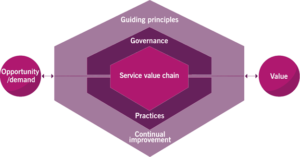Requirements
- Have a high school diploma or degree.
- Complete an accredited training course or self-study.
- Have minimum 2 Years of IT experience.
- Score at least 65% on the certification exam.
Features
- Fostering a strong alignment between IT and business.
- Achieving greater visibility into IT costs.
- Improving customer service and quality of service.
- Minimizing service disruptions.
- Managing risk.
- Relying on the industry standard.
- Unlocking a competitive advantage
Target audiences
- It Service Executives
- IT Managers
- Quality Analysts
- Service-Support Engineers
- Operations Managers
- IT Technical Support Professionals
- Database Administrators
Featured Review
ITIL (Information Technology Infrastructure Library) is a framework designed to standardize the selection, planning, delivery, maintenance and overall lifecycle of IT services within a business.
What is the ITIL 4 Service Value System?
The ITIL Service Value System is the new key component of ITIL 4. The ITIL SVS outlines the overall activities and components of the organization required as a system to validate the generation of value. The activities, elements, and resources can be designed in collective fusion for an organization.

Service Value System: Understanding the Practices, Elements, and Importance
The Service Value System is the key foundation of ITIL 4. The ITIL SVS and ITIL 4 practices describe how the overall components and activities of the organization collaborate and perform together as a system to generate value. Every organization’s Service Value System has confluence with other organizations forming a system that simplifies value creation for the organizations by meeting the needs of their stakeholders and customers. Most of these organizations engage in value-chain activities.
While the ITIL Service is a powerful setup for the governance and management of products and services. A coherent approach to aid in organizations’ performance to consistently create value in an efficient manner. It acts as a guide chart of the required elements and proficiency in order to manage an effective, distinct, and agile service management organization and handle users during the occurrence of issues. It will have the need for cooperation with teams, authorities, activities, responsibilities, and approaches.
The various components of the Service Value System are:
– ITIL Guiding Principles
– Governance
– Service Value Chain
– Practices
– Continual Improvement
Five Elements of the Service Value System
ITIL Guiding Principles: These implement and recommend the principles, working processes, and decisions, for an organization to keep up in all occurrences.
For example: how to collaborate, promote, decision-making, value, mission, work and promote.
Governance: It is the second component of the Service Value System. A method that provides the controls for monitoring, directing, assess for an organization’s performance. The governance activities try to keep the organizations to remain in track with operations and the methods implemented by the governing bodies.
Service Value Chain: The service value chain in ITIL 4 SVS is a set of activities in which an organization influences various ITIL practices to convert inputs into outputs (products or services to achieve value for consumers). This component is an operating model that consists of six activities to create or demand value i.e., planning, engagement, designing, obtaining, delivering and supporting, and optimizing.
Practices: Practice is another component which is the expansion of processes, capabilities, and outcomes from the older type of ITIL model.
They are a set of organizational resources that aims to achieve an objective or goal depending on the elements of the four dimensions of service management.
Continual Improvement: The ITIL continual improvement model (renamed from CSI in Version 3) makes certain that the organizational performance constantly fulfills the stakeholder’s expectations. Continual improvement brings a consistent focus on customer value through a high level of organizational activities to support practices, services, and initiatives.




